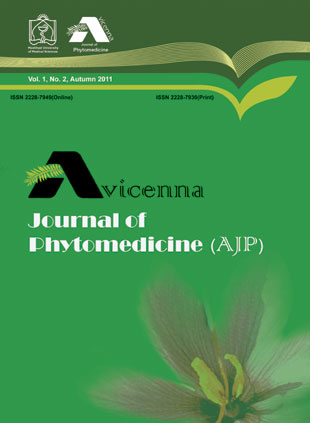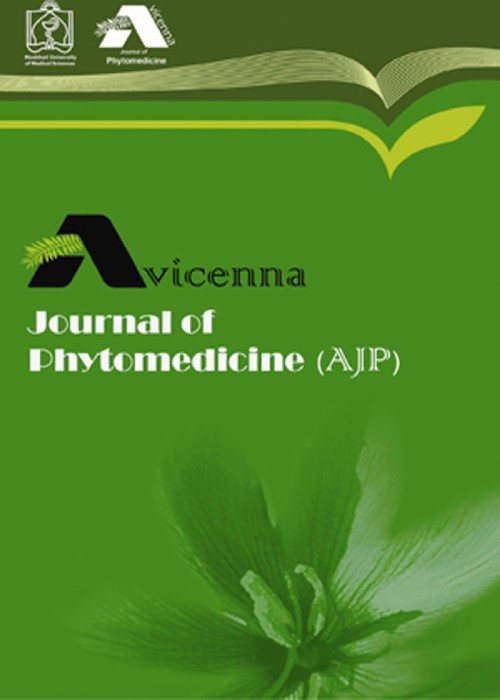فهرست مطالب

Avicenna Journal of Phytomedicine
Volume:1 Issue: 2, Autumn 2011
- تاریخ انتشار: 1390/06/20
- تعداد عناوین: 8
-
-
Page 57ObjectiveDuring the ancient times, saffron (Crocus sativus L.) had many uses around the world; however, some of these uses were forgotten throughout the history. But a newly formed interest in natural active compounds brought back the attention toward historical uses of saffron. Understanding different uses of saffron in the past can help us finding the best uses at present. In this study, we reviewed different uses of saffron throughout the history among different nations.MethodsISI web of Science and Medline, along with references of traditional Iranian medicine were searched for historical uses of saffron.ResultsSaffron has been known since more than 3000 years ago by many nations. It was valued not only as a culinary condiment, but also as a dye, perfume and as a medicinal herb. Its medicinal uses ranged from treating eye problems to genitourinary and many other diseases in various cultures. It was also used as a tonic agent and antidepressant drug among many nations.Conclusion(s)Saffron has had many different uses such as a food additive and a palliative agent for many human diseases. Thus, as an important medicinal herb, it is a good candidate with many promising potentials to be considered for new drug design.
-
Page 67ObjectivePunica granatum, commonly known as pomegranate, has emerged as a medicinal plant with potential antimicrobial activity. The present study was planned to evaluate this activity against both Gram positive Staphylococcus aureus (S. aureus) and negative Pseudomonas aeruginosa (P. aeruginosa) bacteria as well as against pathogenic yeast, Candida albicans (C. albicans).Material And MethodsThe aqueous and methanolic extracts of pomegranate fruit skin were prepared using a Soxhalet apparatus. Antimicrobial effect of the extracts was studied and compared with commercial antibiotics using three different methods; agar dilution, cylinder plate, and disk inhibition zone techniques.ResultsBoth extracts showed good antibacterial activity against S. aureus and P. aeruginosa. Also the methanolic extract presented strong antifungal effect on C. albicans. The antimicrobial activities against S. aureus, P. aeruginosa and C. albicans were comparable with those of cloxacillin, gentamycin and clotrimazole, respectively. The methanolic extract was found to be more effective than aqueous one against all the tested microorganisms.ConclusionThe extracts from pomegranate fruit skin possess strong antimicrobial activity against the tested microorganisms. Therefore this plant could be an important source of new antimicrobial compounds to treat bacterial and fungal infections.
-
Page 74ObjectiveCancer is a major health problem worldwide and current therapies for cancer are often limited by short-term efficacy due to drug resistance. There has been much interest in the use of naturally occurring compounds with chemo-preventive and chemotherapeutic properties in the treatment of cancers.Rose is one of the most important groups of ornamental plants which their fruits and flowers are used in a wide variety of foods, nutritional products and different traditional medicines.Material And MethodsIn this study cytotoxic effect of Rosa damascena extract was evaluated on HeLa cell line. HeLa cells were cultured in DMEM medium and incubated with different concentrations of Rosa damascene (R. damascene) extract. Cell viability was quantitated by MTT assay.ResultsRosa decreased cell viability in malignant cells in a concentration and time dependent manner. The IC50 values against HeLa were determined as 2135, 1540 and 305.1 µg.ml-1 after 24, 48 and 72h, respectively.ConclusionIt might be concluded that R. damascena could cause cell death in HeLa cells which could be also considered as a promising chemotherapeutic agent in cancer treatment in future.
-
Page 78ObjectiveAntiepileptic drugs (AEDs) that are usually used for treatment of epilepsy have substantial side effects and about 30% of patients continue to have seizures with current AEDs therapy. Some herbs which traditionally used in the management of seizures of many rural areas of the developing countries have shown anticonvulsant activity in modern pharmacological bioassays. The aim of the present study was to evaluate the effects of berberine, an alkaloid from Berberis vulgaris, on seizures induced by pentylenetetrazol (PTZ) in rats.Material And MethodsRats (n=6-7) received berberine (100, 200 and 400 mg/kg, i.p.), diazepam (4mg/kg, i.p. as positive control), and vehicle (saline) and then 30 min later PTZ (110mg/kg, i.p.) were injected. Behavioral responses of the animals to PTZ administration were evaluated using these criteria: latency to first minimal clonic seizure (MCS), incidence of MCS, latency to the first generalized tonic–clonic seizures (GTCS), incidence of GTCS, protection against GTCS and mortality.ResultsIntraperitoneal administration of lower doses of berberine (100 and 200 mg/kg) had no significant effects on minimal clonic seizures (MCS) and generalized tonic-clonic seizures (GTCS) latencies, while injection of 400 mg/kg caused significant increase in both MCS and GTCS latencies (p<0.05). In this study diazepam, (4 mg/kg) 30 min prior to PTZ, significantly increased GTCS latency. Berberine at tested doses had no protection against mortality following PTZ administration.ConclusionIt can be concluded that berberine at high doses could be a useful protective agent in PTZ-induced epileptic seizures in rats.
-
Page 83ObjectivesEvaluation of therapeutic effects of Carum copticum (C. copticum) has been the subject of several studies in recent years. Thymol the major component of C. copticum is a widely known anti-microbial agent. In this study, the antibacterial and anti viral activities of essential oil of C. copticum fruit were determined.Materials And MethodsEssential oil of C. copticum was analyzed by means of gas chromatography-mass spectrometry (GC-MS). The antimicrobial activity of the oil was evaluated against six Gram (+/-) bacteria and fungi, using the micro broth dilution technique. Antiviral activity of the essential oil was evaluated using a Bacillus phage CP51.ResultsFrom the ten identified constituents, representing 98.7% of the oil, thymol (72.3%), terpinolene (13.12%) and o-cymene (11.97%) were the major components. It was found that the oil exhibited strong antimicrobial activity against Staphylococcus aureus (S. aureus) and Bacillus subtilis (B. subtilis) (MIC, 0.00025% v/v). Furthermore, the antiviral activity of the oil was evaluated by plaque reduction assay.ConclusionThe essential oil showed an antiviral activity against phage when phage was pre-incubated with the essential oil prior to its exposure to B. cereus and without any pre-incubation with the phage, suggesting that the oil directly inactivated virus particles.
-
Page 91ObjectiveRosa damascena mill L (R. damascena) is an ornamental plant that has several therapeutic (such as sedative and hypnotic) effects. It also heals depression, grief, nervous stress and tension. In the present study we evaluated antidepressant-like effect of R. damascena using forced swimming test (FST).Material And MethodsThree doses of aqueous extract (15, 60 and 90 mg/kg) was injected intraperitoneally. After 30 min of injection, immobility and swimming times were measured and compared with control (negative control) and imipramine (positive control).ResultsThe results showed that low dose (15mg/kg) of extract significantly increased swimming time and decreased immobility time. However, the two high doses of extract (60 and 90mg/kg) had no significant effect on these parameters.ConclusionThese results proposed antidepressant-like effect of low concentration of aqueous extract of R. damascena.
-
Page 98ObjectivesMangifera indica (Mango) is used in folk medicine for treatment of different types of diseases, and its anti-inflammatory and free radical scavenging activities have been demonstrated. The present study evaluated the effects of commercial (vimang) and hydroalcoholic extract of Mango on gentamicin-induced nephrotoxicity in rat.Materials And MethodsFemale Wistar rats were treated with vimang (50 and 100 mg/kg) for 18 days, or hydroalcoholic extract (200 and 400 mg/kg) for 18 days as preventive groups and others with vimang (100 mg/kg) for 8 days, or hydroalcoholic extract (400 mg/kg) for 8 days as treatment groups and also gentamicin (GM) was used at 80 mg/kg/day for eight days, starting from day 10. At the end of treatment, blood and urine samples were taken for measurement of creatinine (Cr) and BUN. The kidney was prepared for histological evaluation.ResultsSerum Cr and urea concentrations as well as renal tissue injury increased significantly in GM group compared with the control group. Hydroalcoholic extract of Mango at 200mg/kg was able to reduce plasma Cr and urea concentrations significantly as well as kidney tissue necrosis. Vimang (50 and 100 mg/kg) and hydroalcoholic extract of Mango (200mg/kg) also prevented kidney tissue damage compared with the control group.ConclusionMango products were able to improve kidney function in an established model of GM-induced nephrotoxicity in the rat. The beneficial effects of Mango on the rat kidney seem to be dose and time-dependent. However, more investigations are needed to elucidate Mango action on GM-induced renal toxicity.
-
Page 106ObjectiveOriganum vulgare L. is rarely cultivated in Iran but it is the only species of the Origanum genus growing wild in this country. O.vulgare L. is widely spread all over the country. In this study, parameters of content, composition and antioxidant activity of the essential oils of domestic and wild Iranian Oregano populations were compared with one another.Materials And MethodsThe extractions were performed using a clevenger-type apparatus and the essential oils in the Oregano plants were obtained by hydro-distillation and analyzed by GC/MS.ResultsThe essential oils were obtained in the Oregano field at yield of (0.80%) and the 4 provenance Oregano (ranging from 0.93% to 1.66% v/w). In cultivated plant 22 constituents, representing 94.02% and in 4 provenance plants (O.v-w1--- O.v-w4), 21, 25, 22, 20 constituents, representing 96.55%, 95.66%, 95.8%, 94.48% of the oils, respectively, were identified. The two major constituents of the essential oils, carvacrol ranging from 23.54 to 67.09% and, γ-terpinene ranging from 7.71 to 20.94% were present in relatively equal amounts in all five samples from different localities. Five chemotypes of essential oils were identified. The main chemotype was carvacrol-γ-terpinene. Furthermore, the antioxidant activity of essential oils of O.vulgare using DPPH radical scavenging was determined. All extracts exhibited almost the same pattern of antioxidant activity as ascorbic acid (vit C).ConclusionOur findings demonstrated that the chemical composition of the essential oils of O. vulgare L. varies considering geographical location of collection site, climate and other ecological conditions which suggest both intrinsic/genetic and extrinsic/environmental factors such as: altitude, edaphic, temperature, humidity and climate, may play important roles in deter mining the oils composition.


